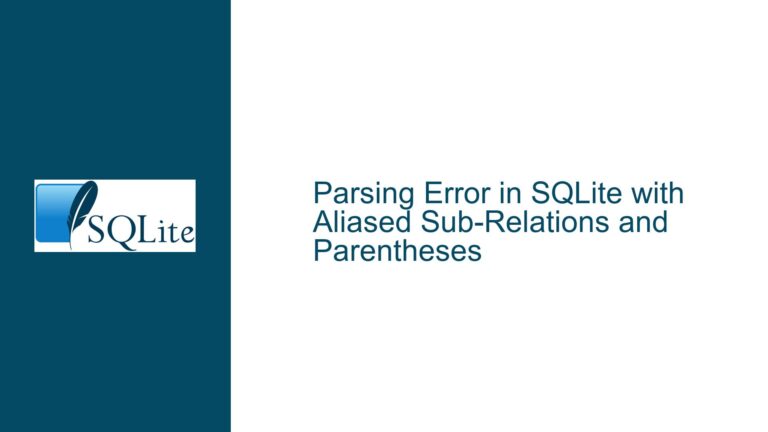Retrieving Current Property Owners with SQLite Queries
Understanding the Problem: Retrieving the Most Recent Owner for Each Property
The core issue revolves around constructing a SQLite query to retrieve the most recent owner for each property from a database that tracks property ownership over time. The database schema includes a table with columns for OwnerID, Address, Owner, and PurchaseDate. The goal is to generate a result set that lists only the current owner for each property, based on the most recent PurchaseDate.
The challenge lies in ensuring that the query correctly identifies the most recent purchase date for each address and retrieves the corresponding owner. This requires sorting the data by Address and PurchaseDate, then filtering to retain only the most recent entry for each address. The query must handle cases where some properties have had multiple owners over time, while others have had only one.
Common Pitfalls and Misconceptions in Query Construction
One of the primary pitfalls in constructing such a query is the misuse of the GROUP BY clause. While GROUP BY is essential for aggregating data, it can lead to incorrect results if not paired with the appropriate aggregate functions or if the query logic does not account for the specific requirements of the task. For instance, simply grouping by Address and selecting the maximum PurchaseDate may not suffice if the query does not also retrieve the corresponding Owner and other relevant details.
Another common misconception is that sorting the data alone will solve the problem. Sorting by PurchaseDate and then selecting the last few records may yield partial results but fails to account for the need to group by Address and retrieve the most recent entry for each unique address. This approach can lead to missing data, as seen in the initial attempts where sorting by date or street address alone did not produce the desired output.
Additionally, there is a potential issue with date formats. SQLite understands dates in the ISO8601 format (YYYY-MM-DD), but if dates are stored in a different format, such as MM-DD-YYYY, the query logic must include steps to convert these dates into a format that SQLite can interpret correctly. Failure to do so can result in incorrect comparisons and sorting, leading to inaccurate results.
Step-by-Step Solutions and Query Optimization Techniques
To address the problem effectively, we can employ several SQLite-specific techniques and best practices. Below, we outline a detailed step-by-step approach to constructing the query, along with explanations of each step and the underlying logic.
Step 1: Understanding the Data Structure
Before constructing the query, it is essential to understand the structure of the data. The table in question has the following columns:
OwnerID: A unique identifier for each ownership record.Address: The street address of the property.Owner: The name of the property owner.PurchaseDate: The date on which the property was purchased by the owner.
The goal is to retrieve the most recent PurchaseDate for each Address and the corresponding Owner.
Step 2: Using Aggregate Functions and GROUP BY
The first step in constructing the query is to use the GROUP BY clause in conjunction with the MAX aggregate function. The MAX function will help identify the most recent PurchaseDate for each Address. However, simply using GROUP BY and MAX will not suffice because we also need to retrieve the corresponding Owner and other details.
Here is an initial attempt at the query:
SELECT Address, MAX(PurchaseDate) AS MostRecentPurchaseDate
FROM PropertyOwnership
GROUP BY Address;
This query will correctly identify the most recent PurchaseDate for each Address, but it does not retrieve the corresponding Owner. To include the Owner, we need to join this result back to the original table.
Step 3: Joining the Aggregated Results with the Original Table
To retrieve the Owner and other details, we can use a subquery or a Common Table Expression (CTE) to first identify the most recent PurchaseDate for each Address, and then join this result back to the original table to retrieve the corresponding Owner.
Here is an example using a subquery:
SELECT po.Address, po.Owner, po.PurchaseDate
FROM PropertyOwnership po
JOIN (
SELECT Address, MAX(PurchaseDate) AS MostRecentPurchaseDate
FROM PropertyOwnership
GROUP BY Address
) AS recent ON po.Address = recent.Address AND po.PurchaseDate = recent.MostRecentPurchaseDate;
In this query, the subquery (recent) identifies the most recent PurchaseDate for each Address. The main query then joins this result back to the original PropertyOwnership table (po) to retrieve the corresponding Owner and other details.
Step 4: Handling Edge Cases and Data Integrity
One potential edge case is the possibility of multiple owners for the same property on the same date. This could occur due to data entry errors or corrections. To handle this, we can modify the query to ensure that only one record is returned for each Address, even if there are multiple owners with the same PurchaseDate.
Here is an updated version of the query that uses the ROW_NUMBER() window function to handle this edge case:
WITH RankedOwners AS (
SELECT
Address,
Owner,
PurchaseDate,
ROW_NUMBER() OVER (PARTITION BY Address ORDER BY PurchaseDate DESC) AS rn
FROM PropertyOwnership
)
SELECT Address, Owner, PurchaseDate
FROM RankedOwners
WHERE rn = 1;
In this query, the ROW_NUMBER() function assigns a unique rank to each row within each Address partition, ordered by PurchaseDate in descending order. The outer query then filters to retain only the rows where rn = 1, which corresponds to the most recent PurchaseDate for each Address.
Step 5: Incorporating Additional Data from Related Tables
In some cases, the query may need to retrieve additional information from related tables, such as building details or unit information. This can be achieved by joining the results of the previous query with the relevant tables.
For example, if we have a BuildingTable that contains additional details about each property, we can modify the query as follows:
WITH RankedOwners AS (
SELECT
po.Address,
po.Owner,
po.PurchaseDate,
ROW_NUMBER() OVER (PARTITION BY po.Address ORDER BY po.PurchaseDate DESC) AS rn
FROM PropertyOwnership po
)
SELECT ro.Address, ro.Owner, ro.PurchaseDate, bt.BuildingType, bt.ConstructionYear
FROM RankedOwners ro
JOIN BuildingTable bt ON ro.Address = bt.Address
WHERE rn = 1;
In this query, the RankedOwners CTE identifies the most recent owner for each property, and the main query joins this result with the BuildingTable to retrieve additional details about each property.
Step 6: Optimizing the Query for Performance
As the database grows, the performance of the query may become a concern. To optimize the query, we can take several steps:
Indexing: Ensure that the
AddressandPurchaseDatecolumns are indexed. This will speed up the sorting and grouping operations.CREATE INDEX idx_address ON PropertyOwnership(Address); CREATE INDEX idx_purchasedate ON PropertyOwnership(PurchaseDate);Limiting the Scope: If the query only needs to consider recent data, we can add a
WHEREclause to limit the scope of the query to a specific date range.WITH RankedOwners AS ( SELECT po.Address, po.Owner, po.PurchaseDate, ROW_NUMBER() OVER (PARTITION BY po.Address ORDER BY po.PurchaseDate DESC) AS rn FROM PropertyOwnership po WHERE po.PurchaseDate >= '2010-01-01' ) SELECT ro.Address, ro.Owner, ro.PurchaseDate, bt.BuildingType, bt.ConstructionYear FROM RankedOwners ro JOIN BuildingTable bt ON ro.Address = bt.Address WHERE rn = 1;Using CTEs: As shown in the previous examples, using CTEs can make the query more readable and easier to optimize. CTEs also allow for modular construction of complex queries, making it easier to test and refine individual components.
Step 7: Testing and Validation
After constructing the query, it is crucial to test it with a variety of data scenarios to ensure that it produces the correct results. This includes testing with properties that have had multiple owners, properties with only one owner, and edge cases such as multiple owners on the same date.
Here is an example of how to test the query using a sample dataset:
-- Create the PropertyOwnership table
CREATE TABLE PropertyOwnership (
OwnerID INTEGER PRIMARY KEY,
Address TEXT,
Owner TEXT,
PurchaseDate TEXT
);
-- Insert sample data
INSERT INTO PropertyOwnership (OwnerID, Address, Owner, PurchaseDate) VALUES
(1, '100 Main Street', 'John Smith', '2010-10-22'),
(2, '110 Main Street', 'Bill Johnson', '2012-08-03'),
(3, '120 Main Street', 'Mary Adams', '2015-04-01'),
(4, '110 Main Street', 'Robert Ownens', '2016-03-15'),
(5, '110 Main Street', 'William Smith', '2018-04-20');
-- Execute the query
WITH RankedOwners AS (
SELECT
Address,
Owner,
PurchaseDate,
ROW_NUMBER() OVER (PARTITION BY Address ORDER BY PurchaseDate DESC) AS rn
FROM PropertyOwnership
)
SELECT Address, Owner, PurchaseDate
FROM RankedOwners
WHERE rn = 1;
The expected output of this query should be:
Address Owner PurchaseDate
100 Main Street John Smith 2010-10-22
110 Main Street William Smith 2018-04-20
120 Main Street Mary Adams 2015-04-01
This output confirms that the query correctly identifies the most recent owner for each property.
Conclusion
Constructing a query to retrieve the most recent owner for each property in SQLite requires a combination of aggregate functions, GROUP BY, and window functions. By understanding the data structure, handling edge cases, and optimizing the query for performance, we can achieve the desired results efficiently. The step-by-step approach outlined above provides a comprehensive guide to solving this problem, ensuring that the query is both accurate and performant.






